|
Page < 1 2 3 4 5 6 7 8 9 10 11 12 13 14 15 >
Hindu
Gods and Goddesses in Bangkok
For generations, Hindu Gods and Goddesses have
occupied a special place in the hearts and minds of many Thai
Buddhists as well as foreign visitors, especially from other
Asian countries.

Phra
Phrom: Lord Brahma
- Erawan Shrine at the Grand Hyatt Erawan Hotel.
(source:
webmaster's own collection of photos taken during a recent visit).
Hindu
Gods and Goddesses are also immensely popular among local and
foreign worshippers, especially the Chinese from Indonesia,
Malaysia, Taiwan and Hong Kong.
***
One unique place in Bangkok where you may observe
or worship these deities is the Ratchaprasong intersection,
where many of the city's upscale shopping and hotel complexes
are situated. Last Wednesday was a special day at the extremely
popular Brahma shrine in front of the Grand Hyatt Erawan Hotel.
Hundreds of Thais and foreign faithful flocked to the shrine to
pay obeisance and pray for fulfilment of their desires. Apart
from the Brahma shrine, set up in 1956, there are five other
prominent shrines in the vicinity of Ratchaprasong intersection.
San Phra Phrom or Erawan Shrine was created as a spirit house
connected to the Erawan Hotel, which has now made way for the
Grand Hyatt Erawan Hotel. The forces of the typical Thai spirit
house didn't seem effective enough during the building of the
hotel, so spiritual persons advised that it should be replaced
with the four-headed image of Brahma or Phra Phrom in Thai.
There have been no further hitches since then, and the shrine
has became famous for bringing good fortune. The name Erawan
comes from Brahma's thirty-three headed elephant.
Thai-Buddhist tradition associates
Brahma with creation. Brahma is believed to have ridden
a three-headed elephant named Erawan,
hence the connection with the Bangkok hotel, and the use of small
elephants at both the Eastern shrine in Bangkok and the Western
shrine in Las Vegas. The four faces of
the Brahma statue represent the Four Divine States of Mind: Loving
Kindness, Compassion, Sympathy and Equanimity.
At Caesars Palace, the Brahma Shrine stands as a tribute to an
ancient culture, and a wish for prosperity and good luck to all
who visit the resort.

Lord
Ganesha at night sits majestically in an exquisitely crafted shrine
outside the Bangkok World Trade Center, Thailand.
***
A statue of the elephant god
Ganesh sits in front of Isetan shopping centre, while
the Trimurti, a form of Brahma, Vishnu, and Siva, adorns the
front of Zen department store.

Trimurti,
a form of Brahma, Vishnu, and Siva, adorns the front of Zen
department store.
(source:
webmaster's own collection of photos taken during a recent visit).
***
At the Intercontinental Hotel near Gaysorn
Plaza, Narayana, another name for Lord
Vishnu, is mounted on his celestial vehicle Garuda,
while the plaza itself has the Statue of the Goddess Uma Parvati
on its fourth floor. Opposite Gaysorn is the Amarin Plaza, where
the rain god Lord Indra stands majestically.
The property-owners view Hindu Gods and Goddesses
as helpful for the prosperity of their businesses. For instance,
the owners of the original Erawan Hotel decided to build a
prominent shrine to the four-faced Brahma back in 1956 after
several workers lost their lives in mysterious construction
accidents. Essentially, the shrine was intended to ward off
misfortune. Since its consecration, the shrine has become a
model for similar ones nationwide.

Kinnar:
Celestial beings in Sanskrit. Thailand.
***
Besides property-owners, all
these shrines of Hindu Gods and Goddesses are also immensely
popular among local and foreign worshippers, especially the
Chinese from Indonesia, Malaysia, Taiwan and Hong Kong.
Chen
Siek Hui, an Indonesian-Chinese,
said she had returned to Bangkok last week after a trip to
Vietnam to offer prayers at the Erawan Brahma shrine and thank
the deity for answering her prayer. "I prayed here last
year when my business ran into trouble. I believed Brahma would
give me the courage and strength to solve the problems. Now my
business is running smoothly, so I came back to say thank you,
and while I was here I asked for better health for my
mother," she said. A relative of Hui, who accompanied her
to Bangkok, said there were several Brahma shrines in Indonesia
but Hui had great faith in the one at the Erawan Hotel. Besides
Indonesian-Chinese, the Erawan Brahma shrine often sees
worshippers from Taiwan, Hong Kong and Malaysia, including
celebrities.
Among
these is Taiwanese movie star Nicolas
Tse, who said that his
prayer had been answered after he visited the shrine.
(source: Hindu
Gods and Goddesses in Bangkok -
Refer to Thailand
Hinduism).
Top
of Page
Hindu
influence in Thai Culture
In the Buddhist Thai kingdom, the Hindus
constitute about one-tenth of the population. However, various
aspects of Hinduism are deeply entrenched in Thai society.
Although it sometimes is difficult to distinguish the Hindu
elements in Thai culture, Hinduism has survived in Thailand
through the concepts of royalty, festivals, music, architecture,
the pantheon of Hindu deities, language, and literature.
The Hindu dharmasastras (religious scriptures), the
concept of kingship, and Hindu rituals have become essential
features of state formation, and rulers have legitimized their
position with the help of brahmans (priests, phrams in Thai).
These priests perform various rituals connected with royalty.
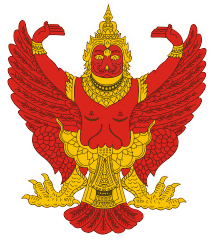 In the Rajyabhiseka ceremony (consecration),
they invoke the blessings of Hindu deities and present royal
regalia to the king, and Thai ceremonies adhere to the tenets of
the Satapatha Brahmana and Aitreya Brahmana. In the Rajyabhiseka ceremony (consecration),
they invoke the blessings of Hindu deities and present royal
regalia to the king, and Thai ceremonies adhere to the tenets of
the Satapatha Brahmana and Aitreya Brahmana.
The
steed of the Hindu God Lord Vishnu Garuda is the Royal symbol of
Thailand.
The influence of Hinduism is also
ingrained in popular Thai
culture. Icons of Hindu gods and goddesses have been discovered
in ancient excavations, and sculptures of such icons as Parvati,
Hanumana, Ganesha, Vishnu, Indra, and Brahma adorn wats
(temples) in Thailand. Images of Ganesha, the patron of Thai arts, are sometimes
installed in newly constructed buildings. Hindu deities are
worshipped along with Buddha and phis (spirits). Even to the
present, the Thai congregate at the Erawan (Brahma’s elephant)
shrine in Bangkok to invoke Brahma.
The Ramayana tradition is important
in Thailand. In the process of adoption, the stories of Ramayana
have been transformed into a Thai version known as the Ramakien. Performing arts forms
like classical dance, masked plays, theater shows, and shadow
plays have continuously used the themes of this classic. The
Thai features in these works are so predominant that only the
origin of the Ramakien remains as a nonindigenous element.
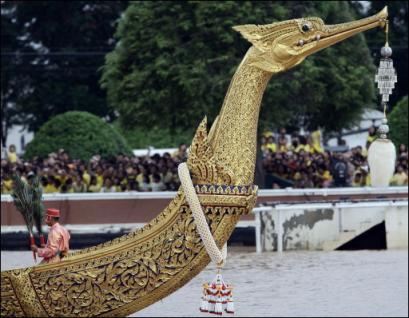
The
Subanahongsa or Golden hamsa (swan) of Lord Brahma.
The
Subanahongsa, or golden hamsa, passes the Grand Palace in Bangkok.
The Subanahongsa refers to the swan-like mythical steed of the
Hindu god Brahma, which first appeared in Thai lore during the
Ayutthaya period. King Rama I ordered the vessel built soon after
his accession to the throne in 1782.

The Subanahongsa, or golden hamsa, passes the
Grand Palace in Bangkok during a rehearsal for the upcoming
ceremonies to mark Thai King Bhumibol Adulyadej's 60th anniversary
to throne.
***
An admixture of Hindu
and Buddhist elements exists in the popular festivals like Loh
Chingecha (swing ceremony), Loi Krathong (festival of lights),
Baruna Satra (rain festival), and Songkran (astrological New
Year). The
Brahmans also have a role in such family ceremonies as births,
deaths, purifications, and weddings. The similarities of
Thai beliefs in the existence of the other world with such Hindu
concepts as savan (paradise) and narok (hell) and with the Hindu
names for deities (devata), worship (pussa), and God (isuan)
point toward the cultural interaction between Thailand and
India. Thai society has shown a tremendous capacity to harmonize
Hindu elements and yet retain its distinct identity.
(source: Hinduism
- Thailand). (For
more refer to chapter on Greater
India: Suvarnabhumi and
Sacred
Angkor).
Top
of Page
The Thai King's Coronation
The coronation ceremony in Thailand consists of the Rajabhiseka,
(Hindu, the Rajasuya), the
anointment. The ceremonial bath constitutes an important
initiatory ritual. The Thai king uses
water of five rivers in the kingdom, the Cau Brahya, the Sak, the
Rajapuri, the Bejrapuri and the Paupahkhan. His counterpart in
India uses the waters of the Ganga, Mahi, Yamuna, Sarayu and
Airavati.
Water is the most significant in the coronation ceremony of
Thailand. The significance of water is fully discussed in the
Hindu treatise, Aitareya Brahmana.
The king invokes the waters for their blessing:
“Look upon ye waters with favorable eye! Touch my skin
with your happy body. I invoke all the fires which reside in the
waters to bestow on me splendor, strength and vigor.”
The officiating priest, Brahmin
continues:
“With these waters which are most happy, which cure
everything, increase the royal power, the immortal Prajapati
sprinkled Indra, Soma, the King, Varuna, Yama, Manu, with the same
sprinkle I thee! “
The Thai king then takes his seat on the Octagonal Throne
beneath the seven-tiered white umbrella of State. He receives here
further anointment. The throne in the Thai ceremony is made of Udumbara
wood (figwood) as prescribed in the Hindu ritual:
“The reason that the throne-seat, the ladle, and the
branch is of Udumbara tree is because the Udumbara is vigor and a
nourishing substance. The priest thus places vigor in the king.”
The Thai throne is spread with hya ga, the Indian darbha or
durva grass. The Thai king, like the ancient Hindu king of India,
always sits on the throne facing the east.
(source:
Hinduism in Thai Life - By Santosh N
Desai p. 1 - 40).
Top
of Page
Ganga
(Ganges water) jal for Thai King's anniversary celebrations
Bangkok: Sacred
river waters of India will be brought to Thailand next week on
April 21 as part of national celebrations to mark the Thai
King’s 60th anniversary on the throne in June.
Water from
the Ganges, Yamuna, Saraswati, Saryu and Gomati rivers will be
brought by the Thai government’s Religious Affairs department
and Hindu organisations in Thailand, said religious
affairs department Director-General Preecha Kantiya.
Monarchs from 28 countries will
attend the special event on June 12 and 13 this year marking 60
years of the accession of King Bhumibol Adulyadej who is the
world’s longest ruling monarch. A priest from the Thai royal household bureau
will travel to India to collect the holy water from Indian
priests, the official said.
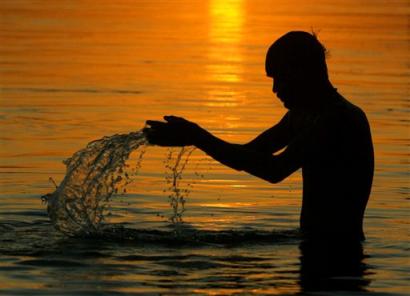
Sacred
Ganga
Watch
video - Brahmins
in
India
have become a minority
Watch
Scientific
verification of Vedic knowledge
***
The water will be taken to
Devasthan,
the Hindu temple in Bangkok from where it will be collected by the
Hindu Samaj Association after religious ceremonies. The water will
be taken to other Hindu temples in Bangkok where Buddhists also
worship.
“Thai and Indian priests will jointly conduct the
rituals," said Preecha. The holy water will finally be
presented to the King on May 5 which is the coronation day.
Although Buddhism is the national
religion, Thai culture and religious beliefs carry the imprint of
significant elements of Hinduism.
(source: Ganga
jal for Thai King's anniversary celebrations -
dnaindia.com).
***
Pilgrimage
to the Holy Waters of India
King Bhumibol Adulyadej's 60th Anniversary on the accession to the
Throne
 King
Bhumibol Adulyadej celebrates his 60th anniversary on
the throne in Thailand in the year 2006 by the Gregorian count and
2549 from the life of Buddha count. King Bhumibol is the longest
reigning monarch in Thailand and in the world. The significance of
the King's reign is probably little understood by people from
other countries, but to the people of Thailand, however, this
enduring monarch, who will be 79 years of age this December 5th,
signifies something bordering on a heavenly occasion reserved for
the gods. King
Bhumibol Adulyadej celebrates his 60th anniversary on
the throne in Thailand in the year 2006 by the Gregorian count and
2549 from the life of Buddha count. King Bhumibol is the longest
reigning monarch in Thailand and in the world. The significance of
the King's reign is probably little understood by people from
other countries, but to the people of Thailand, however, this
enduring monarch, who will be 79 years of age this December 5th,
signifies something bordering on a heavenly occasion reserved for
the gods.
Buddhist
and Brahma (Phram) ceremonies have been planned for a very long
time, and living in Thailand, as I do, its hard not to see the
devotion which Thai people give to their King. It is safe to say
that King Bhumibol is the most revered monarch in the world. And
as far as monarchies go in Southeast Asia the influence of preceding
dynasties of Kingship can be traced back to the Khmer Empire which
ruled for over 1000 years at Angkor Wat in Cambodia and was
finally sacked by Thai armies in 1431AD. The
legends of the Khmer empire and their influence on Thai royalty is
evident through the strong influence of Hinduism when conducting
sacred ceremonies in Thailand. Brahmin priests were influential in
guiding the Thai monarchy to what it has become today unlike the
monarchy in Cambodia which has little influence over the people. The
monarchies of Laos and Burma (Mynamar) have been completely
removed.
At the grand palace in Bangkok
there is a scale model of the
Angkor Wat temple
which is testimony
to the reverence Thais have for their Khmer ancestor Kings.
So
today in the early 21st century the influence
of Hinduism in Thailand with the accompanying offerings
and prayers to Brahma is as important to Thais as Lord Buddha. In
fact it is a Royal decree that both Buddha and Brahma have equal
spiritual significance when it comes to making prayers and merit
making.
However, the Buddha is more
widely recognized as the dominant spiritual teacher whereas Brahma
is looked upon as a God.
To
demonstrate how important Brahma is to the Thai people was made
starkly obvious when a deranged man destroyed the sacred Erawan
shrine housing Lord Brahma in Bangkok.
The emotional outpouring from the Thai nation was voiced in all
the newspapers.
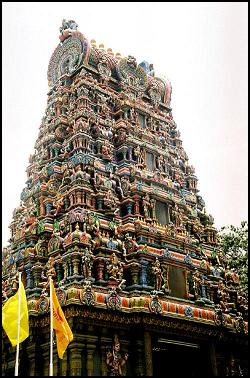 The Erawan Shrine
is the
most sacred shrine in Bangkok that harks back to Vedic times, and
the Emerald Buddha in the grand place is the most sacred Buddhist
shrine. Interestingly enough the emerald Buddha was taken from
Laos. The Thai people take their devotion to heart and the
destruction of the Erawan shrine brought a deep spiritual aspect
of the Thai people to the surface.
The Erawan Shrine
is the
most sacred shrine in Bangkok that harks back to Vedic times, and
the Emerald Buddha in the grand place is the most sacred Buddhist
shrine. Interestingly enough the emerald Buddha was taken from
Laos. The Thai people take their devotion to heart and the
destruction of the Erawan shrine brought a deep spiritual aspect
of the Thai people to the surface.
To
recognize the royal occasion of the king's longevity as a monarch
the president of the council overseeing the affairs of the Hindu
temple at Wat Phra Si Maha Uma Devi (Wat
Phra Si Maha Mariamman) on Silom Road in Bangkok
decided to send a high Brahmin priest to
India where water would be collected from the most
sacred spots of India's five most sacred rivers and brought back
to Bangkok.
The
Holy Water would then travel to three Hindu temples before finally
being presented to the King on Coronation Day, May 5th, 2006. On
April 30th the Holy Water was to be set in Wat Phra Si Maha Uma
Devi.
Having just returned from a
pilgrimage to the Holy Land of Kuruksetra in Champassak Laos, the
site of the 5th century Shiavite temple Vat Phu, I was well
acquainted with the influence the Hindu Gods had on the people.
The
five rivers in India where the Holy Water was taken from was the Ganges,
Yamuna, Saraswati, Saryu, and Gomati rivers. It struck
me that even after 2000 years the spiritual powers associated with
India are playing a dominant role in what will be the worlds most
sanctified ceremony on Coronation Day using Holy Water from India.
Learning
that this Holy Water for His Majesty would be housed at a Hindu
temple in the heart of Bangkok prompted me to make a pilgrimage
from Nakhon Sawan to pay my respects to the Holy Water.
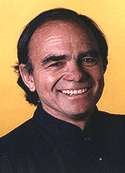 After
experiencing Vat Phu and
the sacred mountain of Lingaparvata
in Laos, I realized it was more than
curiosity that was drawing me to Bangkok. I could sense the
spiritual devotion still strong in Southeast Asia coming from
India. After
experiencing Vat Phu and
the sacred mountain of Lingaparvata
in Laos, I realized it was more than
curiosity that was drawing me to Bangkok. I could sense the
spiritual devotion still strong in Southeast Asia coming from
India.
Refer to chapter on ancient Laos - Glimpses
XVIII
Where
Vat Phu has a sacred spring constantly flowing into a catchment
for pilgrims to drink and do personal ablutions, here in Bangkok
was going to be water from the holy rivers of India. An
opportunity to go see these five rivers in India may not be
possible for me in this life time, but I knew I could travel to
Bangkok, which I did, to witness the Holy Water ceremonies
surrounding the central shrine at Wat Phra Si Maha Uma Devi.
Unlike pilgrims 2000 years ago who would walk
hundreds of miles to dip in one of the holy rivers in India I
found myself leaving at 6AM in the morning in a mini van that
would take three hours from Nakhon Sawan to Bangkok. The only
sense of an ancient pilgrimage I could feel was watching the
sunrise spreading it's early morning orange glow over the rice
paddys as the van made its way to Bangkok. This was an effort I
knew I had to make to continue the thread of continuity from my
emotional experiences I had with Shiva and Uma on the top of
Lingaparvata in those windy early morning hours of February 10,
2006.(source:
Pilgrimage
to the Holy Waters of India - By Willard Van De Bogart).
This article was contributed to this site by author. For more
refer to A
Pilgrimage to Vat Phu
(For
more refer to chapter on Greater
India: Suvarnabhumi and
Sacred Angkor).For a documentary on
Hindu temples, refer to The
Lost Temples of India. Watch
video - Brahmins
in
India
have become a minority
Princess
From Ayudhya - Maha
Chakri Sirindhorn
 Introduction:
She's Thai royalty, and a scholar in Indic lore. Also, a keen
student of things modern.
Princess Maha Chakri Sirindhorn of
Thailand
practises her Sanskrit, reads Pali scriptures and
traipses around rural
India
looking at development projects to emulate for her people. And she
goes to Tata Motors to check out the Nano. In her spare time, she
writes poetry and children's books. She can discuss different
versions of the Ramayana
prevalent in
Southeast Asia
, play three instruments and speak four languages. Introduction:
She's Thai royalty, and a scholar in Indic lore. Also, a keen
student of things modern.
Princess Maha Chakri Sirindhorn of
Thailand
practises her Sanskrit, reads Pali scriptures and
traipses around rural
India
looking at development projects to emulate for her people. And she
goes to Tata Motors to check out the Nano. In her spare time, she
writes poetry and children's books. She can discuss different
versions of the Ramayana
prevalent in
Southeast Asia
, play three instruments and speak four languages.
On
a recent trip to
India
, a country the princess visits often, Maha Chakri spoke of the
ancient ties binding
Thailand
and Southeast Asia to
India
. "Most scholars in
Thailand
study Pali, the language of the word of Buddha. My ancestors did
it and my grandmother studied Pali and Sanskrit," she said.
Dressed simply in a black skirt and jacket with not a hint of
make-up, Maha Chakri said learning the Devanagari script was the
toughest. Her teacher at university was Satyavrat
Shastri, an Indian scholar who had gone to
Thailand
to teach Sanskrit. He has since returned and on her
visits to
India
, the princess always makes it a point to meet him.
"He
would talk a lot about philosophy and literature. When we talked,
he would cite Sanskrit verses to illustrate his point. He could
remember everything," the princess recalled. Shastri studied
the Thai version of the Ramayana
and composed it in Sanskrit verse. Many episodes in the Thai
version are different-a big demon abducts Ram and takes him to the
nether world from which Hanuman rescues him. Ravana is an
extremely important character, shown as wise and a victim of a
certain unfairness by the gods.
Ravana in
his former life had served them but they inflicted pain upon him
and he wanted to avenge his honour in the next life. "It is
the story of revenge. It is difficult to say who is evil and who
is right in battle. It is the same today," Maha Chakri noted.
All Thai children grow up with the story of the Ramayana,
and some episodes of the Mahabharata
also are part of the Thai cultural milieu. Her
quiet but significant forays to
India
help rev up these old bonds that seemed so natural and organic
once upon a time. It was in the first century AD that Indian
merchant princes from our eastern and southern shores reached what
are today
Thailand
,
Indonesia
,
Laos
and
Cambodia
, carrying textiles and other goods. The locals adopted their
culture, building vast temple cities bearing names and statues of
Hindu gods. A fascination for Indian culture developed, and people
closely followed and absorbed aspects they found interesting. It
was a time when
India
was seen as a more affluent and powerful country, worthy of
emulation.
Elements of Hindu
culture have survived in
Thailand
and other countries through festivals, royal religious practices,
music and language. Royal Thai priests come to
India
to learn the rituals, and many Hindu
deities can still be seen in Thai temples. The
king himself is considered an avatar of Lord
Vishnu.
(source:
Princess
From Ayudhya -
By Seema
Sirohi on Maha Chakri Sirindhorn Outlook May 5, 2008).
Page < 1 2 3 4 5 6 7 8 9 10 11 12 13 14 15 >
|